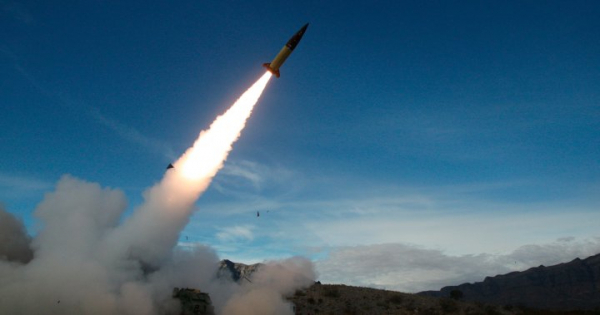In a pivotal moment of solidarity, the United States has swiftly moved to fortify Ukraine's defense capabilities, unleashing a barrage of advanced weaponry to bolster its resistance against Russian aggression. Amidst the ongoing conflict, Ukraine has wasted no time in deploying the formidable long-range weapon systems furnished by the U.S., marking a significant escalation in the conflict dynamics.
The monumental stride comes on the heels of a monumental aid package, as the U.S. Senate, in a resounding affirmation, greenlit a staggering $61 billion allocation for Ukraine's defense. Months of bureaucratic wrangling culminated in the passage of this vital legislation, empowering President Joe Biden to expedite the transfer of army tactical missile systems (ATACMS) to Ukraine, a mandate embedded within the comprehensive aid bill.
Surprisingly, revelations surfaced that President Biden had previously sanctioned the delivery of ATACMS in February, with reports confirming their utilization in a recent strike on a Russian airfield in Crimea. With the ink barely dry on the legislation, National Security Advisor Jake Sullivan affirmed the imminent dispatch of additional missiles, highlighting the unwavering commitment to Ukraine's cause.
However, amidst the fervor of military support, Sullivan tempered expectations, cautioning against the misconception of a singular solution to the conflict. The strategic deployment of ATACMS underscores a paradigm shift in tactics, once deemed excessively provocative but now deemed imperative in Ukraine's struggle for survival.
The decision to arm Ukraine with these potent weapons signals a seismic shift in the calculus of international support, reflecting a recalibration from mere survival to the pursuit of victory. As Colin Robertson astutely observes, the evolving narrative encapsulates a fundamental question: are we merely spectators in Ukraine's plight or active proponents of its triumph?
Indeed, the urgency to equip Ukraine mirrors the evolving nature of modern warfare, where adaptability and resilience reign supreme. Sullivan's allusion to Russia's utilization of long-range ballistic missiles sourced from North Korea underscores the imperative of parity in the conflict theater.
As the specter of conflict looms large, the dispatch of ATACMS embodies more than mere munitions; it symbolizes a potent testament to the enduring resolve of nations united against aggression and tyranny. In the crucible of conflict, Ukraine stands not alone, fortified by the unwavering support of allies committed to its defense and freedom.
As tensions escalate on the Ukrainian frontlines, the Biden administration wastes no time in mobilizing a formidable $1 billion weapons package, heralding the onset of a new phase in the conflict dynamics. Swiftly following the enactment of the monumental aid bill, President Biden unveils plans for immediate deliveries, poised to reinforce Ukraine's defense capabilities within a matter of hours.
Addressing the press from the White House, Biden outlines the breadth of support, encompassing a diverse array of armaments ranging from air defense munitions to artillery, rocket systems, and armored vehicles. However, conspicuous in its absence from the discourse is any explicit mention of long-range weapons, raising speculation regarding the timeline for their deployment.
The urgency underlying the aid dispersal underscores the precarious predicament faced by Ukraine, confronting an adversary that dwarfs them in sheer manpower and firepower. John Kirby, the White House national security spokesperson, encapsulates the gravity of the situation, emphasizing Ukraine's dire need for swift and substantial assistance.
Revelations of clandestine ATACMS deliveries, shrouded in secrecy to avert diplomatic ramifications, cast a spotlight on the delicate geopolitical calculus underpinning military aid provision. The evolution of U.S. support, from initial hesitancy over escalation concerns to proactive engagement, mirrors the shifting sands of international diplomacy.
The strategic deployment of HIMARS and air defense systems heralded a turning point in Ukraine's defense strategy, affording them the means to repel Russian advances and reclaim occupied territories. Buoyed by these successes, Ukraine's plea for long-range missiles gains traction, highlighting their resolve to confront Russian aggression head-on.
While apprehensions regarding escalation persist, the solidarity displayed by European allies, epitomized by the United Kingdom and France's provision of precision-guided cruise missiles, underscores a collective commitment to Ukraine's cause. With a range of approximately 240 kilometers, these munitions promise to bolster Ukraine's offensive capabilities and strike at the heart of Russian encroachment.
Amidst the specter of conflict and diplomatic maneuvering, one truth remains resolute: the unwavering resolve of nations united in support of Ukraine's sovereignty and security. As the battlefield evolves and alliances solidify, the trajectory of the conflict hinges not only on military might but also on the diplomatic ingenuity of stakeholders vested in a peaceful resolution.
Following the trail of conflict, Kyiv's strategic prowess shines through as Storm Shadow missiles unleash devastating blows on Russian naval assets, submarines, and military nerve centers entrenched in occupied territories, notably Crimea. The United Kingdom's recent announcement of additional Storm Shadow shipments underscores the pivotal role of these precision munitions in Ukraine's defense arsenal.
Amidst the clandestine maneuverings of international diplomacy, the United States quietly embarked on supplying a truncated version of ATACMS to Ukraine in October 2023, ostensibly to mitigate escalation fears. Despite official silence, Ukrainian President Zelenskyy lauded the efficacy of these systems in combat, attesting to their precision and impact against Russian forces.
While boasting a range of up to 300 kilometers, the ATACMS variants dispatched last autumn possess a shorter reach, approximately 160 kilometers, coupled with the deployment of cluster munitions. This unconventional payload renders them formidable adversaries, evading conventional air defense measures and posing a significant threat to Russian targets.
Contrary to the linear trajectory of cruise missiles like Storm Shadow and SCALP, ATACMS projectiles follow a ballistic trajectory, confounding defense systems and bolstering Ukraine's offensive capabilities. Republican proponents of U.S. aid to Ukraine, led by Senator Mitch McConnell, advocate for expedited deployment of long-range ATACMS, dismissing concerns of escalation in the face of relentless Russian aggression.
Kurt Volker, a seasoned diplomat with insights into NATO and Ukrainian affairs, rebukes notions of Ukrainian restraint, asserting their inherent right to retaliate against Russian incursions originating from Russian territory. With reports surfacing of Ukraine's inaugural use of longer-range ATACMS on April 17, the stakes of the conflict escalate further, shrouded in uncertainty regarding Ukraine's strategic calculus.
As fervent appeals for heightened military support echo across the international stage, apprehensions linger regarding the ramifications of escalated hostilities. The imperative to navigate the delicate balance between bolstering Ukraine's defense capabilities and averting catastrophic escalation underscores the complexity of the geopolitical quagmire confronting policymakers and analysts alike.
As the conflict intensifies, Kyiv's aggressive tactics extend beyond conventional warfare, triggering a contentious debate over the ethical boundaries of military engagement. Recent reports unveil Ukraine's provocative foray into drone strikes targeting critical oil and energy installations deep within mainland Russia, notably a strike in Tatarstan, marking a significant escalation in cross-border hostilities.
The audacious campaign, punctuated by relentless assaults on Russia's Black Sea fleet, underscores Ukraine's resolve to confront its adversary on multiple fronts. However, amidst the fervor of combat, concerns mount regarding the potential for collateral damage and civilian casualties.
Richard Shimooka, a seasoned analyst specializing in defense policy, voices apprehensions over the lack of safeguards governing Ukraine's utilization of ATACMS, urging vigilance to prevent inadvertent strikes on civilian infrastructure within Russian territory. While acknowledging Ukraine's precision in targeting military assets, Shimooka highlights the inherent risks of misfire and the catastrophic consequences of civilian casualties.
Amidst the cacophony of conflict, the specter of unintended escalation looms large, prompting a sober appraisal of the strategic calculus underlying Ukraine's military operations. The imperative to balance offensive capabilities with ethical considerations remains a paramount concern, eliciting ongoing scrutiny from international observers and policymakers alike.
As the conflict unfolds, navigating the fine line between military necessity and humanitarian imperative emerges as a formidable challenge, underscoring the complexities inherent in contemporary warfare. Against this backdrop of uncertainty, the quest for safeguards to mitigate the risk of unintended consequences remains an urgent imperative, lest the flames of conflict engulf innocent lives and exacerbate an already volatile crisis.
In conclusion, as Ukraine's conflict with Russia enters increasingly contentious territory, the debate surrounding the ethical parameters of warfare intensifies. While Kyiv's assertive tactics demonstrate a commitment to repel aggression and safeguard its sovereignty, concerns persist regarding the potential for unintended escalation and civilian casualties. The imperative for stringent safeguards to govern military operations, particularly regarding the use of advanced weaponry such as ATACMS and drone strikes, becomes paramount. Amidst the complexities of modern warfare, striking a delicate balance between military necessity and humanitarian imperatives remains a formidable challenge. As the international community grapples with the ramifications of escalating hostilities, a concerted effort to uphold ethical standards and mitigate the risk of collateral damage is essential to averting further tragedy and fostering a path towards lasting peace and stability in the region.






